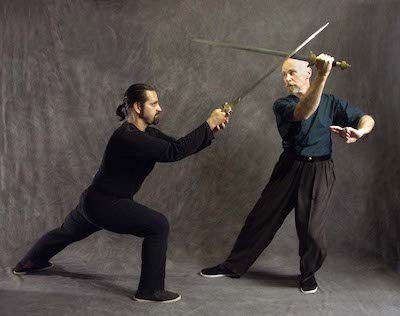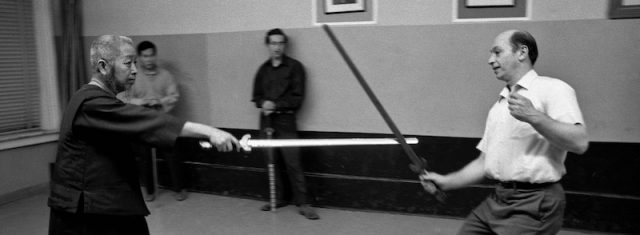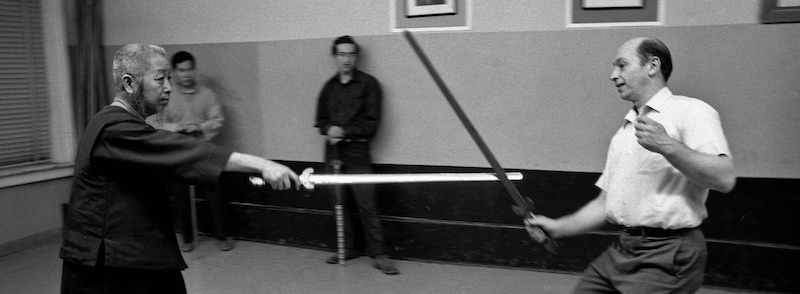Tai Chi approaches fencing pragmatically. Its function is martial; its purpose is therapeutic and philosophical.
We fence within rather strict principles and without rules, except for the general rule to cause no harm to your partner.

The manner of fencing should be the same as it would be if we were in a duel. It is said in western fencing that, “The best defence is a good offence”. In Tai Chi fencing we hold defence to be the over-riding priority.
One of our core principles is that we aspire to ‘touch’ the opponent as we maintain defensive contact, in other words ‘safely’.
Western fencing has become a sport; the fencers must achieve a certain amount of touches. If one gets five to the opponent’s four he is quite happy to be the winner. If A were in an actual duel and managed to get four light touches (wounds) on B and B only manages one on A, that one touch may have been fatal. It behoved the duellist to approach his adversary with courage mixed with a great measure of prudence. All of the complicated and elegant moves that they practised in the Salle* are abandoned for the most basic, simple and effective moves.
The great Italian fencer Aldo Nadi put it this way: “The duellist’s objective is to injure his adversary as soon as possible without being wounded at all, the fencer’s is to defeat his opponent in no particular hurry, (under international rules a fencer is allowed ten minutes to win a bout with five touches) as long as he scores at least a fraction of a second before he may be touched himself. In a duel the fencer is compelled to execute an ultra careful form which indeed is an unworthy version of the vast science he knows.”
So it is clear that eastern fencing offers a much more varied and elegant forum for the player than western duelling. On the other hand Tai Chi swordsmanship ideally, and under its principles, should be the same in fencing as in duelling.
A duel that is undertaken because of a challenge or an insult is not condoned under the principles of Tai Chi. It should only be done to save lives or if one is attacked. This is exemplified in the opening moves of the Tai Chi Sword form, in which the Sword, held in the left hand, executes five defensive moves while still in its scabbard, before the sword is drawn.

Another rule, (or ‘preferred option’ in Tai Chi), is choice of target. In western fencing the target is designated. With Foil one only gets points for touching on the torso. This is because the Foil is the sport version of the small sword, which is almost exclusively a thrusting weapon. With sabre, the target is from the waist up including arms and head. The sabre is a much lighter version of the duelling sabre, which is mostly slashed and occasionally used as a thrust. With the Epee there is no limitation of target. The Epee evolved from the Rapier through the Epee de Combat, which mostly used the thrust and rarely cut.
Cheng Man Ch’ing told us that it is best to strike the target that is offered and, if one has a choice, to cut to the right hand or forearm first of all, because it is closer and therefore safer, since one stays farther away while touching that target. Secondly if one were in a real duel and killed the opponent, their relatives might seek vengeance. Of course we may never be in a duel, but this goes to illustrate the basic pacifism of Cheng Man Ch’ing’s approach.
* Salle, ‘the fencing school’.- ON BEING A MASTER – Tai Chi Sword 53
- STRANGERS – Tai Chi Sword 52
- PADDED SWORDS – Tai Chi Sword 51
- SAFETY – Tai Chi Sword 50
- PARALLELS – Tai Chi Sword 49
- Swordsmanship – SEVEN QUOTES – Tai Chi Sword 48
- TI FENG & FA JING – Tai Chi Sword 47
- SUPPOSITIONS – Tai Chi Sword 46
- LAO TZU (Laozi) QUOTES – Tai Chi Sword 45
- ETIQUETTE – Tai Chi Sword 44
- FENCING PROCESS – Tai Chi Sword 43
- STRATEGIES – Tai Chi Sword 42
- TASSELS IN THE WIND – Tai Chi Sword 41
- SHOOT FLYING GOOSE – Tai Chi Sword 40
- RHINOCEROS GAZES AT MOON – Tai Chi Sword 39
- THE MASTER SITS BACK – Tai Chi Sword 38
- FIVE APPLICATIONS – 1. BLOCK AND SWEEP – Tai Chi Sword 37
- RULES OF ENGAGEMENT – Tai Chi Sword 36
- CONSIDER – Tai Chi Sword 35
- INVITATIONS – Tai Chi Sword 34
- THE TASSEL – Tai Chi Sword 33
- THE SWORD FINGERS – Tai Chi Sword 32
- Cheng Man Ching Photographs
- THE JOINTS – Tai Chi Sword 31
- THE GRIP – Tai Chi Sword 30
- SWORD MOVEMENT – Tai Chi Sword 29
- ON ALIGNMENT – Tai Chi Sword 28
- CONCERNING THE CENTRE – Tai Chi Sword 27
- EQUATIONS – Tai Chi Sword 26
- HSIN AND CHI – Tai Chi Sword 25
- On studying – NINE QUOTES – Tai Chi Sword 24
- THE SWORD MAIDENS – Tai Chi Sword 23
- THE SWORD AND CALLIGRAPHY – Tai Chi Sword 22
- Returning – MORE THOUGHTS – Tai Chi Sword 21
- Levels of TAI CHI SWORD – Tai Chi Sword 20
- FENCING – Tai Chi Sword 19
- Transcendence – Tai Chi Sword 18
- TURNING TRICKS – Tai Chi Sword 17
- Names of CHENG MAN CH’ING’S TAI CHI SWORD – Tai Chi Sword 16
- FORCE – Tai Chi Sword 15
- DIFFERENCES – Tai Chi Sword 14
- BEGINNERS’ MISTAKES – Tai Chi Sword 13
- MIND SETS – Tai Chi Sword 12
- SENSITIVITY – Tai Chi Sword 11
- HARMONY – Tai Chi Sword 10
- TIME AND HUMOUR – Tai Chi Sword 9
- WHY AND HOW – Tai Chi Sword 8
- SWORD DIMENSIONS – Tai Chi Sword 7
- A ROYALTY OF ARMS – Tai Chi Sword 6
- KENNETH VAN SICKLE – Tai Chi Sword 4
- CHENG MAN CH’ING – Tai Chi Sword 5
- PREFACE – Tai Chi Sword 3
- Introductory Thoughts – Tai Chi Sword 2
- EDITOR’S PREFACE -Tai Chi Sword 1
- Tai Chi Sword by Kenneth van Sickle
Author and Images: Ken van Sickle
German version on our sister site!





